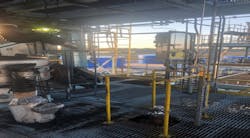Birla Carbon Migrates DCS for Continuous Optimization
Bill Mackin, senior project engineer with Birla Carbon, gave attendees of the Siemens Automation Summit 2019 unique insights into the DCS (distributed control system) migration currently underway at the company’s North Bend plant in Louisiana. Birla Carbon is a producer of high-quality Carbon Black—a carbon powder used to make rubber, plastics, and ink. The company is a flagship business of the Aditya Birla Group, generating $300 million in annual revenues.
Birla Carbon’s North Bend plant is a 160-acre site built in 1954. It is the largest producer of Carbon Black in the United States and employs 153 people. The plant houses two production units: a high volume/high yield Rubber Unit for producing Carbon Black for tires and a high-quality Specialty Unit for producing Carbon Black for paints, plastics, and printer cartridges. The plant’s primary feedstock is petroleum.
Upgrades to the plant control system, originally installed between 1995 and 1999, began in 2013 with the installation of 12 Siemens APACS controllers—nine in the Rubber Unit and three in the Specialty Unit. The Specialty Unit and Rubber Unit upgraded to the Siemens PCS7 operating system in 2014 and 2015, respectively. In 2016 a standalone Profibus motor control center (MCC) was installed in the Specialty Unit to manage 58 motors, followed by the installation of PCS7 AS 410 and Profinet in this same MCC to manage 30 motors.
2018 saw the beginning of Birla Carbon’s full migration to PCS7, including OS (operating system) virtualization and device integration. This migration is expected to be complete in 2021, with the final stage addressing burner management.
Mackin says the production objectives associated with these technology upgrades include:
- Improving oil utilization through the use of multiple variables (density, temperature, flow) from existing reactor oil flow meters to better manage yield;
- Improving process efficiencies with interlock faceplates, alarm conditioning, improved graphics, and DCS logic resolution around tail gas valve systems and bag collector blowdown;
- Integration of digital technologies on all new devices (e.g., transmitters, starters, drives);
- Increasing monitoring points by adding instrumentation throughout the entire carbon black production process; and
- Working with process engineering group to develop key performance indicators and apply analytics to production data for continuous process optimization.
With new control and instrumentation technologies in place, Mackin said specific goals for the company include using the software simulation to make the system “a living system we can use to help train operators to perform multiple jobs and move away from having to do as much manual manipulation of control loops.”
Other benefits recognized by the company with the new DCS in place include the ability to focus on efficiency improvements around engineering, yield, and downtime, as well as the ability to better address the material management sections of the production process encompassing 100 motors and 122 transmitters.
Highlighting some of the results recently achieved from the migration in the Specialty Unit’s operations, Mackin said the unit has “broken multiple daily production records in 2019 and was recognized with a company productivity award in the first quarter.” He added that engineers can also now better identify back-end process interrupts as well as improve setup conditions and make maintenance modifications.

